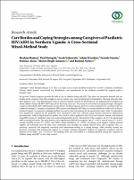| dc.contributor.author | Mujjuzi, Ibrahim,Paul,Sarah,Ashim,Fazirah,Patience,Sharon Bright, Richard Mutegeki,Nabuwufu,Wosukira,Namata, Alayo, Amanya ,and Nyeko | |
| dc.date.accessioned | 2021-09-17T09:09:09Z | |
| dc.date.available | 2021-09-17T09:09:09Z | |
| dc.date.issued | 2021 | |
| dc.identifier.citation | Mujjuzi, I., Mutegeki, P., Nabuwufu, S., Wosukira, A., Namata, F., Alayo, P., ... & Nyeko, R. (2020). Care Burden and Coping Strategies Among Caregivers of Paediatric HIV/AIDS in Northern Uganda: A Cross-sectional Mixed-method Study. | en_US |
| dc.identifier.uri | https://doi.org/10.1155/2021/6660337 | |
| dc.identifier.uri | https://hdl.handle.net/123456789/322 | |
| dc.description.abstract | Background. Family caregivers provide the bulk of care to children living with HIV. +is places an enormous demand and care
burden on the caregivers who often struggle to cope in various ways, some of which may be maladaptive. +is may adversely affect
their quality of care. Very little literature exists in resource-limited contexts on the burden of care experienced by caregivers on
whom children living with HIV/AIDS depend for their long-term care. We assessed care burden and coping strategies among the
caregivers of paediatric HIV/AIDS patients in Lira district, northern Uganda. Methods. A mixed-method cross-sectional study was
conducted among 113 caregivers of paediatric HIV patients attending the ARTclinic at a tertiary healthcare facility in Lira district,
northern Uganda. A consecutive sampling method was used to select participants for the quantitative study, while 15 respondents
were purposively sampled for the qualitative data. Quantitative data were collected using standard interviewer-administered
questionnaires, while in-depth interview guides were used to collect qualitative data. Data were entered, cleaned, and analysed
using SPSS version 23. Qualitative data were analysed thematically. Results. +emajority of the caregivers, 65.5% (74), experienced
mild-to-moderate burden. +e mean burden scores significantly differed by caregivers’ age (P � 0.017), marital status (P � 0.017),
average monthly income (P � 0.035), and child’s school attendance (P � 0.039). Accepting social support, seeking spiritual
support, and reframing were the three most commonly used strategies for coping. Marital status and occupation were, respectively,
positively and negatively correlated with information-seeking as a coping strategy, while monthly income was
positively correlated with psychosocial support as a strategy. Seeking community support was negatively correlated with the
duration of the child’s care. Conclusions. Our findings show that care burden is a common problem among the caregivers of
children living with HIV in the study context. | en_US |
| dc.language.iso | en | en_US |
| dc.publisher | Hindawi | en_US |
| dc.subject | HIV/AIDS ,Care Burden and Coping Strategies in Northern Uganda: | en_US |
| dc.title | Care Burden and Coping Strategies among Caregivers of Paediatric HIV/AIDS in Northern Uganda: A Cross-Sectional Mixed-Method Study | en_US |
| dc.type | Article | en_US |

